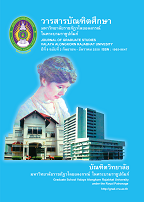การพัฒนาการคิดอย่างมีวิจารณญาณสำหรับนักศึกษาสาขาการศึกษาปฐมวัยโดยรูปแบบ MAPLE
Main Article Content
Abstract
การวิจัยครั้งนี้มีความมุ่งหมายเพื่อ 1) ศึกษาองค์ประกอบของการคิดอย่างมีวิจารณญาณสำหรับนักศึกษาสาขาการศึกษาปฐมวัย 2) สร้างรูปแบบการเรียนการสอน MAPLE สำหรับพัฒนาการคิดอย่างมีวิจารณญาณสำหรับนักศึกษาสาขาการศึกษาปฐมวัย และ3) พัฒนาการคิดอย่างมีวิจารณญาณสำหรับนักศึกษาสาขาการศึกษาปฐมวัยโดยใช้รูปแบบ MAPLE กลุ่มตัวอย่างที่ใช้ในการวิจัย คือ นักศึกษาสาขาการศึกษาปฐมวัยปีที่ 1 ที่ศึกษาในมหาวิทยาลัยราชภัฏภาคเหนือตอนบน ได้แก่ กลุ่มตัวอย่างในการศึกษาองค์ประกอบของการคิดอย่างมีวิจารณญาณ จำนวน 357 คน และกลุ่มตัวอย่างที่ใช้ในการพัฒนาการคิดอย่างมีวิจารณญาณสำหรับนักศึกษาสาขาการศึกษาปฐมวัย โดยรูปแบบ MAPLE ที่ได้เลือกแบบเจาะจง จำนวน 38 คน เครื่องมือที่ใช้ในการวิจัยศึกษาครั้งนี้ คือ รูปแบบ MAPLE และแบบประเมินการคิดอย่างมีวิจารณญาณสำหรับนักศึกษาสาขาการศึกษาปฐมวัย
ผลการศึกษาวิจัยสรุปได้ดังนี้
1.การวิเคราะห์องค์ประกอบเชิงยืนยันการคิดอย่างมีวิจารณญาณสำหรับนักศึกษาสาขาการศึกษาปฐมวัย พบว่า โมเดลการวิเคราะห์องค์ประกอบเชิงยืนยันการคิดอย่างมีวิจารณญาณสำหรับนักศึกษาสาขาการศึกษาปฐมวัย ประกอบด้วย 5 องค์ประกอบ ได้แก่ ด้านการนิยามปัญหา ด้านการพิจารณาข้อมูล ด้านการสมติฐาน ด้านการตีความ ด้านการประเมินผล การคิดอย่างมีวิจารณญาณสำหรับนักศึกษาสาขาการศึกษาปฐมวัยมีความเหมาะสมพอดีกับข้อมูลเชิงประจักษ์ มีน้ำหนักองค์ประกอบในแต่ละด้านมีค่าเป็นบวกอย่างมีนัยสำคัญทางสถิติที่ระดับ .01 ทุกด้าน และสามารถวัดองค์ประกอบการคิดอย่างมีวิจารณญาณสำหรับนักศึกษาสาขาการศึกษาปฐมวัยได้
2.รูปแบบ MAPLE สำหรับพัฒนาการคิดอย่างมีวิจารณญาณสำหรับนักศึกษาสาขาการศึกษาปฐมวัยที่ผู้วิจัยสร้างขึ้นประกอบด้วย 6 หลักการ ได้แก่ หลักการเสริมแรง หลักการกระบวนการคิดทางสติปัญญา หลักการเรียนรู้แบบร่วมมือ หลักการประเมินค่า หลักการปดสัมพันธ์ หลักการเรียนรู้ ขั้นตอนการสอน 5 ขั้น คือ ขั้นสร้างแรงจูงใจ ขั้นวิเคราะห์ ขั้นนำเสนอ ขั้นเรียนรู้ร่วมกัน ขั้นประเมินผล
3.ผลการเปรียบเทียบค่าเฉลี่ยการคิดอย่างมีวิจารณญาณโดยรวมและรายด้านของกลุ่มตัวอย่าง พบว่า หลักการทดลองมีระดับสูงขึ้นกว่าก่อนทดลองอย่างมีนัยสำคัญทางสถิติที่ระดับ .01
The purposes of this research were to 1) the development the development of critical thinking for early childhood education students 2) construct MAPLE Instructional Model to develop the critical thinking for Early Childhood Education Students, and 3) develop the critical thinking for Early Childhood Education Students through the maple. The sample used in the rajabhat University Northern. The sample for the development of students selected by purposive sampling. The MAPLE Instructional Model of students selected by purposive sampling. The MAPLE Instructional MAPLE was used with The experimental group of 38 students. The instruments used in the research were the MAPLE Instructional Model and an evaluation form for the critical thinking for Early Childhood Education Students.
The results of research were as follows.
1.Regarding the confirmatory factor analysis model of Critical thinking for Early Childhood Education Students, it was found that the confirmatory factor analysis model for Early Childhood Education Students comprised five areas of factor: define the problem, consider, hypothesis, interpret and evaluate. The critical thinking model of Early Childhood Education Students fit the empirical data and the weight of all individual areas of factor was positive with statistical significance at the level of .01 and could measure the factors of Early Childhood Education Students.
2.The MAPLE Instructional Model to develop the Early Childhood Education Students constructed by the researcher consisted of six principles. reinforcement principle, the intellectual thought process, Maria knows cooperative principles, Valuation principles, interaction, Learning principles. The five teaching steps were learning from the motivation, analyzing, Presentation, Learning together and evaluation.
3.According to comparison of means of critical thinking in general and in individual areas, it was found that the means after the experiment were higher than those before the experiment with statistical significance at the level of .01
Article Details
บทความทุกเรื่องได้รับการตรวจความถูกต้องทางวิชาการโดยผู้ทรงคุณวุฒิ ทรรศนะและข้อคิดเห็นในบทความวารสารบัณฑิตศึกษา มหาวิทยาลัยราชภัฏวไลยอลงกรณ์ ในพระบรมราชูปถัมภ์ มิใช่เป็นทรรศนะและความคิดของผู้จัดทำจึงมิใช่ความรับผิดชอบของบัณฑิตวิทยาลัย มหาวิทยาลัยราชภัฏวไลยอลงกรณ์ ในพระบรมราชูปถัมภ์ กองบรรณาธิการไม่สงวนสิทธิ์การคัดลอก แต่ให้อ้างอิงแหล่งที่มา


